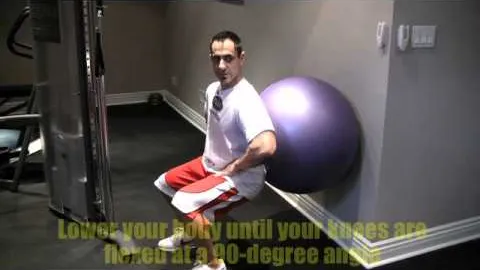
Stability Ball Squat Exercise: A Guide for Building Lower Body Strength
Introduction
The Stability Ball Squat exercises is an effective and versatile movement that targets the lower body muscles, including the quadriceps, hamstrings, and glutes. This exercise is beneficial for individuals of all fitness levels, from beginners to experienced athletes, as it not only improves lower body strength but also enhances balance, stability, and core engagement.
In this guide, we will dive deep into the mechanics of the Stability Ball Squat exercise, its benefits, variations, and how to properly execute it. So let's get started!
Benefits of Stability Ball Squat Exercise
Lower Body Strength: The primary focus of the Stability Ball Squat exercise is to build lower body strength. By targeting the quadriceps, hamstrings, and glutes, this exercise helps to develop strong and well-defined leg muscles.
Improved Balance and Stability: Performing squats on a stability ball requires coordination and balance. This exercise activates the stabilizing muscles in the lower body, improving overall balance and stability.
Core Engagement: To maintain balance on the stability ball, your core muscles need to engage throughout the exercise. This not only adds an extra challenge to the lower body but also strengthens your core muscles.
Increased Range of Motion: As compared to traditional squats, stability ball squats allow for a greater range of motion. This deep squat movement helps to improve flexibility in the hips, knees, and ankles.
Variety and Versatility: Stability ball squats can be modified and progressed to meet individual needs and goals. Variations such as adding weights or incorporating single-leg movements can intensify the exercise and target different muscle groups.
Execution Steps
Performing Stability Ball Squats requires proper form and technique. Follow these steps for a safe and effective workout:
Equipment and Setup: Begin by selecting an appropriate-sized stability ball. It should be positioned against a sturdy wall to prevent any rolling or instability. Stand facing away from the wall with your feet hip-width apart.
Positioning: Slowly walk your feet forward while leaning against the stability ball until it rests against your lower back. The ball should be positioned at the curve of your lower back, keeping your feet shoulder-width apart.
Squat Motion: Engage your core muscles and maintain a neutral spine throughout the movement. Begin bending your knees and lowering your body into a squat position, with your thighs parallel to the ground.
Knee Position: Ensure that your knees are aligned with your feet and do not extend past your toes. This helps to maintain proper form and minimizes strain on the knee joints.
Full Range of Motion: Lower your body until your thighs are parallel to the ground, or as low as comfortably possible. Keep your weight on your heels and maintain control throughout the movement.
Return to Starting Position: Push through your heels and drive your body back up to the starting position. Focus on engaging your glutes and hamstrings as you ascend. Repeat for the desired number of repetitions.
Variations of Stability Ball Squat
To add variety and target different muscle groups, you can try these variations of the Stability Ball Squat exercise:
Weighted Stability Ball Squat: Hold a dumbbell or kettlebell at your chest level while performing the squat. This added resistance challenges your muscles further and promotes strength gains.
Single-leg Stability Ball Squats: Lift one foot off the ground and squat down on the stability ball using only one leg. This variation engages the stabilizing muscles and improves balance.
Leg Press Stability Ball Squat: Position a stability ball between your back and a wall, then perform a squat while pressing against the ball with your back. This variation targets the glutes and hamstrings effectively.
Safety Considerations
While Stability Ball Squats can be highly beneficial, it is important to keep the following safety considerations in mind:
Stability Ball Size: Choose a stability ball that suits your height and weight. Using an inappropriate size can compromise your balance and stability during the exercise.
Gradual Progression: Start with bodyweight squats and gradually increase the difficulty by adding weights or modifying the exercise. Avoid overexertion, which can lead to muscle strains or other injuries.
Proper Form: Maintain proper form throughout the movement. Keep your core engaged, knees aligned, and weight on your heels to prevent unnecessary stress on your joints.
Conclusion
The Stability Ball Squat exercise is a highly effective movement for building lower body strength, enhancing balance, stability, and core engagement. By incorporating this exercise into your fitness routine, you can target various muscle groups in your lower body and improve overall functional fitness.
Remember, safety and proper form are essential when performing Stability Ball Squats. With consistent practice and gradual progression, you will experience the benefits of this exercise and take your fitness journey to new heights.
If you're looking for a gym, fitness club or yoga studio, you've come to the right place.
You can find information about gyms in your area. Browse catalog of gyms and find gyms with classes which are you looking for.
On gym page you can find simple information like address, phone or website. You can find list of available classes. You can check availability of personal training or small group classes. On place page you can also see information about open hours.
You can find gyms near you with amenities, courts, studios and equipments.
Use our map to find gym at your city or district.
In Gym Navigator you can find list of exercises with movies for many body parts.
You can browse exercises catalog and find exercises the best of you.
You can also find exercises grouped into workout plans, which you can use to improve you body. Each routine show you exercises one by one and give you possibility to count you progress and count down rest time.